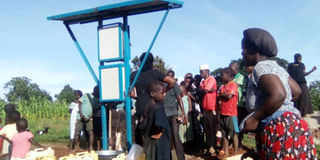Prime
High water coverage brings smiles to Buikwe residents

Facility. Residents of Nkombwe Landing Site in Buikwe District draw water from a public stand tap yesterday. PHOTO BY DENNIS SSEBWAMI
What you need to know:
- A 2010 UN habitat brochure on the water and sanitation initiative in landing sites on Lake Victoria found that 76 per cent of the population lacks access to sustainable supplies of safe drinking water; 72 lacks access to improved sanitation whereas less than five percent of the garbage is being collected by the local authorities.
Buikwe. Residents in Buikwe District have expressed gratitude over the improved safe water coverage in the district.
With a population of 422,771 people, Buikwe’s safe water coverage currently stands at 77 per cent, down from 58 per cent in 2015, according to Buikwe District water officials.
This is above the national rural safe water level of 70 per cent.
Mr Arthur Kayaga, the Buikwe District water officer, says they have so far managed to set up 51 public stand taps at 19 fishing villages in the district.
He says the water project at landing sites is funded by the Iceland International Development Agency (ICEIDA).
“Getting clean water was a big challenge at landing sites and when we received this programme ,we decided to prioritise provision of water which we have well executed,’ he says.
The most excited residents are those living at the 19 landing sites in the district.
According to Ms Josephine Namubiru, a resident of Nkombwe Landing Site in Ngogwe Sub -county, they used to draw water directly from the lake which used to expose residents to water-borne diseases such as diarrhoea, typhoid, and dysentery.
Ms Namubiru says they now draw water from the two public stand taps at the landing site.
Mr Elijah Lubanga, the secretary for Senyi Landing Site, says although they are paying some money at the public stand taps, they no longer spend much on treating diseases.
“Our people are no longer disturbed by water bone diseases, the only problem is in the management. Sometime, the people managing those taps hike prices of water, but as local leaders, we shall sort out that,” he says.
Currently, residents pay Shs100 per 20-litre jerrycan of water.
Buikwe District is among the districts where ICEIDA has been pumping money to uplift the standard of living of people through education, health and provision of safe and clean water. According to Mr Kayaga, they have spent Shs3.8b on extending piped water in the four sub-counties of Ngogwe, Ssi, Najja and Nyenga which are along the shores of Lake Victoria.
According to WaterAid, an international organisation looking to improve access to safe water, sanitation and hygiene, eight million people in Uganda do not have clean water. This is caused by various factors, among which is the high cost of water.
He said Shs100 per 20-litre jerrycan which is being charged from residents is used to cover for the operational costs.
“When there is a problem with water supply, we come in as a district and rectify it,” he says.
Under the same project, Mr Kayaga says the district has also managed to construct 137 pit-latrines to improve sanitation at landing sites. For the pit-latrines, Mr Kayaga says residents will use them without paying any fee.
The Buikwe District Health Officer, Dr Richard Bbosa, says construction of free lavatory facilities has helped reduce open defecation at various landing sites.
“Open defecation has been rampant at landing sites but with new pit-latrines in place, leaders through the set up committees have sensitised people and we have started seeing a considerable improvement in sanitation,” he says.
Report
A 2010 UN habitat brochure on the water and sanitation initiative in landing sites on Lake Victoria found that 76 per cent of the population lacks access to sustainable supplies of safe drinking water; 72 lacks access to improved sanitation whereas less than five percent of the garbage is being collected by the local authorities.




